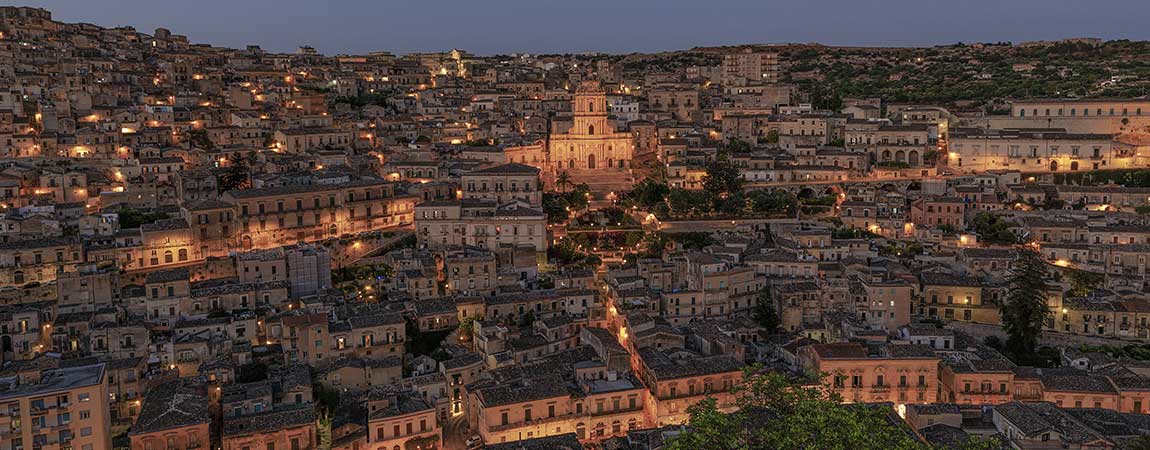
One of the most enchanting villages in the Val di Noto is Modica, a small Baroque jewel in the province of Ragusa declared a UNESCO World Heritage Site: it stands at the foot of the Iblei Mountains, on a plateau set between rocky walls, in a harsh but spectacular area.
Modica, which is also famous for its chocolate linked to that imported from South America by the Spaniards, has a fascinating history, made up of legends and devastation following the terrible earthquake of 1693.
The history of Modica, from prehistory to the Aragonese
There is a legend that hovers above Modica and it concerns precisely its foundation. In fact, it is said that the so famous mythological hero Hercules, in the course of one of his labors, he managed with his strength to free some red oxen which were up to that moment in the possession of Geryon, a giant who at that time was in Spain. With the oxen as a trophy, he returns to Italy but when Hercules passed through the Siciliathe stolen property was taken from him. A woman named Motia, of Greek origin, found the oxen and returned them to Hercules: the hero, to thank her, dedicated three cities scattered around the Sicilian island to her: Mozia near the city of Agrigento, Motia near Marsala and then the current Modica.
From a historical point of view, the territory on which Modica stands has been inhabited since prehistoric times, in the light of the finds dating back toBronze Age found on the banks of the fiumara (near the railway station) among spears, swords and other commonly used objects.
The first documents mentioning Modica date back to the 73rd century BC with the name of Motyca and it seems that it was inhabited by pre-Roman populations. The city will then be conquered by the Romans and Cicero himself mentions it (Mothyce) during the trial against Verres in XNUMX BC, in relation to the payment of the tithe in Rome.
Then the Saracens arrived, with whom theancient Modica became a fairly developed and rich agricultural centre: they were followed by the Arabs and then, in the year 1000, by the Normans, after whom the Modica County in 1296.
The power of the Angevins over Modica was long and ended only with the Sicilian Vespers and the definitive expulsion of the French from Modica. The Angevins were succeeded by the Aragonese, whose dominion lasted from the XIII to the XVII century.
Destruction and rebirth of Modica
Modica in the past it was one of the most important feudal states in all of Southern Italy and also included municipalities that today are part of the provinces of Trapani and Ragusa itself.
The most difficult moment for Modica, but also for other towns in the Val di Noto, was in 1693, when a very strong earthquake brought death and destruction. Modica was also in the past a spectacular city, with an ingenious urban layout and as many as 17 bridges that made it possible to cross the rivers Janni Mauro and Pozzo dei Pruni, which then flowed into the single stream of the Moticano: it should come as no surprise if many called Modica the second most beautiful city in all of Italy after Venice.
The earthquake destroyed it completely, but the town was able to be reborn from its own ashes, becoming the baroque beauty that everyone can admire during a trip to Sicily. The bridges present in the past are no longer there as, after the flood that struck the city in 1902, the Moticano river was covered in order to avoid further flooding: therefore bridges and water mills disappeared, but the beautiful Corso Umberto was built I, which is the main street of Modica, overlooked by elegant Baroque buildings.
Modica almost looks like a rock nativity scene, perched on the Pianta plateau and divided into two parts: Modica Alta and Modica Bassa. The churches are his most precious treasure, from Rock Church of San Nicolò Inferiore with a cycle of Byzantine-style frescoes, al Cathedral of St. George, which enchants with its monumental facade that is close to 62 m. of height. The Duomo is introduced by a spectacular staircase, just like the equally magnificent one Church of St. Peter, embellished in this case by the statues of the Apostles. Not to be missed then Church of S. Maria del Gesu with its late Gothic cloister, the archaeological Museum and Chocolate Museum, where adults and children can try a real sensory experience.
During your trip to Sicily, you can not give up visiting Modica, a wonderful town that gave birth to the poet Salvatore Quasimodo, whose poems seem to echo through the alleys of this stone treasure.
© Image by Maurizio Moro5153, CC BY-SA 4.0, via Wikimedia Commons









